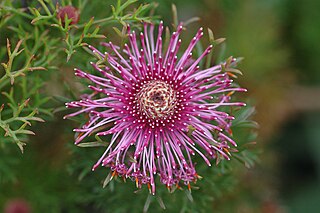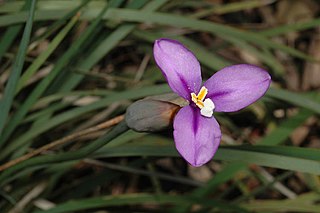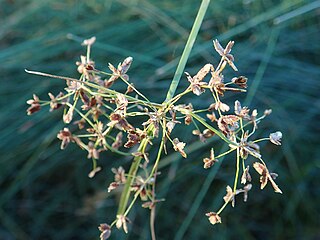
Isopogon formosus, commonly known as rose coneflower, is a species of flowering plant in the family Proteaceae and is endemic to the south-west of Western Australia. It is a shrub with divided leaves with cylindrical segments, and spherical to oval heads of pink or red flowers.

Spinifex longifolius, commonly known as beach spinifex, is a perennial grass that grows in sandy regions along the seacoast. It also lives in most deserts around Australia.

Franklandia is a genus of small shrubs in family Proteaceae, commonly known as lanolin bushes. It is endemic to Southwest Australia.

Anarthria is a genus of flowering plant species endemic to Southwest Australia. The name of the genus is derived from Ancient Greek, meaning 'without joints'.

Johnsonia is a genus five species of herbs in the family Asphodelaceae, all of which are endemic to the south-west of Western Australia. They are grass-like plants with minute flowers surrounded by bracts which are often tinged with white, pink or cream.

Conospermum caeruleum, commonly known as blue brother, is a shrub in the family Proteaceae and is endemic to the south west of Western Australia. It is a prostrate shrub with small, dense heads of blue, rarely pink flowers and usually grows in heavy soils subject to flooding.

Diuris longifolia is a species of orchid which is endemic to the south-west of Western Australia. It has a variety of common names including purple pansy orchid, donkey orchid, common donkey orchid and wallflower orchid. It was one of the first three terrestrial orchids to be named from Western Australia, along with Caladenia menziesii and Caladenia flava.

Petrophile longifolia, commonly known as the long-leaved cone bush is a shrub which is native to the south west of Western Australia, growing between the city of Albany and the Stirling Range.

Melaleuca scabra, commonly known as rough honey-myrtle, is a species of shrub that is endemic to a small area on the south coast of Western Australia. It has warty leaves and profuse, pink to purple heads of flowers between July and November.
Persoonia scabra is a species of flowering plant in the family Proteaceae and is endemic to the south-west of Western Australia. It is an erect to spreading shrub with hairy young branchlets, narrow oblong to lance-shaped leaves, and yellow flowers arranged singly, in pairs or threes, with a scale leaf at the base.

Persoonia teretifolia is a species of flowering plant in the family Proteaceae and is endemic to the south-west of Western Australia. It is an erect, spreading shrub with smooth bark, hairy young branchlets, linear leaves, and bright yellow flowers borne in groups of up to twenty on a rachis up to 100 mm (3.9 in) long that continues to grow after flowering.

Patersonia occidentalis, commonly known as purple flag, or long purple-flag, is a species of flowering plant in the family Iridaceae and is endemic to southern Australia. It is a tufted, rhizome-forming perennial with narrow, sharply-pointed, strap-like leaves, egg-shaped, bluish violet sepals and a cylindrical capsule. The Noongar name for the plant is komma.

Petrophile diversifolia is a species of flowering plant in the family Proteaceae and is endemic to southwestern Western Australia. It is a shrub with pinnate, sharply-pointed leaves, and oval heads of densely hairy, white or creamy-white flowers.

Cyperus concinnus is a sedge of the family Cyperaceae that is native to Australia, and found in New South Wales, Queensland, the Northern Territory, South Australia, Victoria and Western Australia.
Fimbristylis acicularis is a sedge of the family Cyperaceae that is native to northern and north eastern Australia.

Desmocladus flexuosus is a rhizatomous, sedge-like herb in the Restionaceae family, endemic to south-west Western Australia.

Pimelea angustifolia, commonly known as narrow-leaved pimelea, is a small upright, slender or open shrub with whitish, cream, yellow or pink flowers. It is endemic to Western Australia.

Scaevola nitida is an erect shrub in the family Goodeniaceae, native to Western Australia. It grows to a height of 0.3 to 3 m, and its blue-purple flowers may be seen from August to December.
Patersonia lanata, commonly known as woolly patersonia, is a species of flowering plant in the family Iridaceae family and is endemic to the south of Western Australia. It is a tufted perennial herb with sword-shaped leaves and blue-violet flowers.

Lechenaultia tubiflora is a plant in the Goodeniaceae family, endemic to the south-west and south of Western Australia.

















